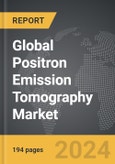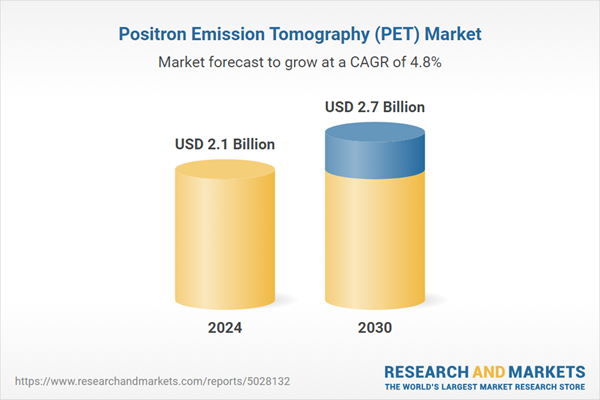The global market for Positron Emission Tomography (PET) was valued at US$2.1 Billion in 2024 and is projected to reach US$2.7 Billion by 2030, growing at a CAGR of 4.8% from 2024 to 2030. This comprehensive report provides an in-depth analysis of market trends, drivers, and forecasts, helping you make informed business decisions. The report includes the most recent global tariff developments and how they impact the Positron Emission Tomography (PET) market.
Segments: Type (Full Ring, Partial Ring); Modality (PET-CT, PET-MRI); Application (Oncology, Cardiology, Neurology, Other Applications); End-Use (Hospitals, Diagnostic Centers, Other End-Uses).
Geographic Regions/Countries: World; USA; Canada; Japan; China; Europe; France; Germany; Italy; UK; Spain; Russia; Rest of Europe; Asia-Pacific; Australia; India; South Korea; Rest of Asia-Pacific; Latin America; Argentina; Brazil; Mexico; Rest of Latin America; Middle East; Iran; Israel; Saudi Arabia; UAE; Rest of Middle East; Africa.
The analysts continuously track trade developments worldwide, drawing insights from leading global economists and over 200 industry and policy institutions, including think tanks, trade organizations, and national economic advisory bodies. This intelligence is integrated into forecasting models to provide timely, data-driven analysis of emerging risks and opportunities.
Global Positron Emission Tomography (PET) Market - Key Trends and Drivers Summarized
Positron Emission Tomography (PET): Unveiling the Intricacies of Human Physiology
Positron Emission Tomography (PET) is a sophisticated imaging technique that enables the visualization and measurement of metabolic processes in the body. Unlike traditional imaging methods that focus on anatomical structures, PET scans provide functional imaging by detecting the gamma rays emitted indirectly by a positron-emitting radiotracer. Typically, the radiotracer is a biologically active molecule labeled with a radioactive isotope, such as fluorodeoxyglucose (FDG), which accumulates in tissues with high metabolic activity. When the radiotracer decays, it emits positrons that collide with electrons, producing gamma rays that are detected by the PET scanner. This process allows clinicians to generate detailed images of biological functions, offering invaluable insights into the physiology and pathology of diseases.How Are Technological Advancements Enhancing PET Imaging?
Technological advancements have revolutionized PET imaging, enhancing its accuracy, resolution, and application scope. The integration of PET with computed tomography (CT) or magnetic resonance imaging (MRI) has resulted in hybrid imaging systems like PET/CT and PET/MRI, combining the functional imaging capabilities of PET with the anatomical detail of CT or MRI. This fusion provides a comprehensive diagnostic tool that improves disease localization and characterization. Advances in detector technology, such as the development of digital PET scanners, have significantly improved image resolution and sensitivity, allowing for earlier and more accurate disease detection. Additionally, innovations in radiotracer development have expanded the range of metabolic and molecular processes that can be visualized, enabling PET to investigate various conditions, from cancer and cardiovascular diseases to neurological disorders.What Are the Key Applications and Benefits of PET Imaging?
PET imaging is widely used in oncology, neurology, cardiology, and infectious disease diagnosis, offering numerous clinical benefits. In oncology, PET is indispensable for detecting, staging, and monitoring the treatment response of various cancers, providing crucial information that guides therapeutic decisions. In neurology, PET scans are used to diagnose and study neurological conditions such as Alzheimer's disease, epilepsy, and Parkinson's disease, by revealing abnormalities in brain metabolism. Cardiologists use PET imaging to assess myocardial perfusion and viability, aiding in the diagnosis and management of coronary artery disease. The ability to provide functional imaging makes PET a powerful tool for tracking disease progression and evaluating the efficacy of treatments. Moreover, the non-invasive nature of PET and its ability to provide quantitative data enhance its utility in both clinical practice and research settings.What Factors Are Driving the Growth in the PET Imaging Market?
The growth in the positron emission tomography (PET) market is driven by several factors. The increasing prevalence of cancer and neurological disorders is a significant driver, as PET imaging is crucial for the accurate diagnosis and management of these conditions. Technological advancements that enhance the resolution, sensitivity, and capabilities of PET scanners are also propelling market growth. The integration of PET with other imaging modalities, such as CT and MRI, has expanded its clinical applications and improved diagnostic accuracy. Additionally, the development of new radiotracers that target specific metabolic pathways and molecular markers is broadening the scope of PET imaging. The rising adoption of PET in clinical research and drug development, coupled with the growing demand for non-invasive diagnostic techniques, is further contributing to market growth. These factors, combined with increasing healthcare expenditure and the expansion of healthcare infrastructure in emerging markets, are driving the sustained growth of the PET imaging market.Report Scope
The report analyzes the Positron Emission Tomography (PET) market, presented in terms of units. The analysis covers the key segments and geographic regions outlined below.Segments: Type (Full Ring, Partial Ring); Modality (PET-CT, PET-MRI); Application (Oncology, Cardiology, Neurology, Other Applications); End-Use (Hospitals, Diagnostic Centers, Other End-Uses).
Geographic Regions/Countries: World; USA; Canada; Japan; China; Europe; France; Germany; Italy; UK; Spain; Russia; Rest of Europe; Asia-Pacific; Australia; India; South Korea; Rest of Asia-Pacific; Latin America; Argentina; Brazil; Mexico; Rest of Latin America; Middle East; Iran; Israel; Saudi Arabia; UAE; Rest of Middle East; Africa.
Key Insights:
- Market Growth: Understand the significant growth trajectory of the PET-CT segment, which is expected to reach US$2.3 Billion by 2030 with a CAGR of a 5.0%. The PET-MRI segment is also set to grow at 3.9% CAGR over the analysis period.
- Regional Analysis: Gain insights into the U.S. market, valued at $553.6 Million in 2024, and China, forecasted to grow at an impressive 8.1% CAGR to reach $591.3 Million by 2030. Discover growth trends in other key regions, including Japan, Canada, Germany, and the Asia-Pacific.
Why You Should Buy This Report:
- Detailed Market Analysis: Access a thorough analysis of the Global Positron Emission Tomography (PET) Market, covering all major geographic regions and market segments.
- Competitive Insights: Get an overview of the competitive landscape, including the market presence of major players across different geographies.
- Future Trends and Drivers: Understand the key trends and drivers shaping the future of the Global Positron Emission Tomography (PET) Market.
- Actionable Insights: Benefit from actionable insights that can help you identify new revenue opportunities and make strategic business decisions.
Key Questions Answered:
- How is the Global Positron Emission Tomography (PET) Market expected to evolve by 2030?
- What are the main drivers and restraints affecting the market?
- Which market segments will grow the most over the forecast period?
- How will market shares for different regions and segments change by 2030?
- Who are the leading players in the market, and what are their prospects?
Report Features:
- Comprehensive Market Data: Independent analysis of annual sales and market forecasts in US$ Million from 2024 to 2030.
- In-Depth Regional Analysis: Detailed insights into key markets, including the U.S., China, Japan, Canada, Europe, Asia-Pacific, Latin America, Middle East, and Africa.
- Company Profiles: Coverage of players such as Advanced Accelerator Applications SA, Best ABT Molecular Imaging, Inc., Curasight A/S, Digiray Corporation, DuchemBio, Co., Ltd. and more.
- Complimentary Updates: Receive free report updates for one year to keep you informed of the latest market developments.
Some of the 42 companies featured in this Positron Emission Tomography (PET) market report include:
- Advanced Accelerator Applications SA
- Best ABT Molecular Imaging, Inc.
- Curasight A/S
- Digiray Corporation
- DuchemBio, Co., Ltd.
- GE Healthcare
- Hitachi Ltd.
- Neusoft Corporation
- PETsys Electronics SA
- Philips Healthcare
Tariff Impact Analysis: Key Insights for 2025
Global tariff negotiations across 180+ countries are reshaping supply chains, costs, and competitiveness. This report reflects the latest developments as of April 2025 and incorporates forward-looking insights into the market outlook.The analysts continuously track trade developments worldwide, drawing insights from leading global economists and over 200 industry and policy institutions, including think tanks, trade organizations, and national economic advisory bodies. This intelligence is integrated into forecasting models to provide timely, data-driven analysis of emerging risks and opportunities.
What’s Included in This Edition:
- Tariff-adjusted market forecasts by region and segment
- Analysis of cost and supply chain implications by sourcing and trade exposure
- Strategic insights into geographic shifts
Buyers receive a free July 2025 update with:
- Finalized tariff impacts and new trade agreement effects
- Updated projections reflecting global sourcing and cost shifts
- Expanded country-specific coverage across the industry
Table of Contents
I. METHODOLOGYII. EXECUTIVE SUMMARY2. FOCUS ON SELECT PLAYERSIII. MARKET ANALYSISCANADAITALYSPAINRUSSIAREST OF EUROPESOUTH KOREAREST OF ASIA-PACIFICARGENTINABRAZILMEXICOREST OF LATIN AMERICAIRANISRAELSAUDI ARABIAUNITED ARAB EMIRATESREST OF MIDDLE EASTIV. COMPETITION
1. MARKET OVERVIEW
3. MARKET TRENDS & DRIVERS
4. GLOBAL MARKET PERSPECTIVE
UNITED STATES
JAPAN
CHINA
EUROPE
FRANCE
GERMANY
UNITED KINGDOM
ASIA-PACIFIC
AUSTRALIA
INDIA
LATIN AMERICA
MIDDLE EAST
AFRICA
Companies Mentioned (Partial List)
A selection of companies mentioned in this report includes, but is not limited to:
- Advanced Accelerator Applications SA
- Best ABT Molecular Imaging, Inc.
- Curasight A/S
- Digiray Corporation
- DuchemBio, Co., Ltd.
- GE Healthcare
- Hitachi Ltd.
- Neusoft Corporation
- PETsys Electronics SA
- Philips Healthcare
Table Information
| Report Attribute | Details |
|---|---|
| No. of Pages | 194 |
| Published | April 2025 |
| Forecast Period | 2024 - 2030 |
| Estimated Market Value ( USD | $ 2.1 Billion |
| Forecasted Market Value ( USD | $ 2.7 Billion |
| Compound Annual Growth Rate | 4.8% |
| Regions Covered | Global |









